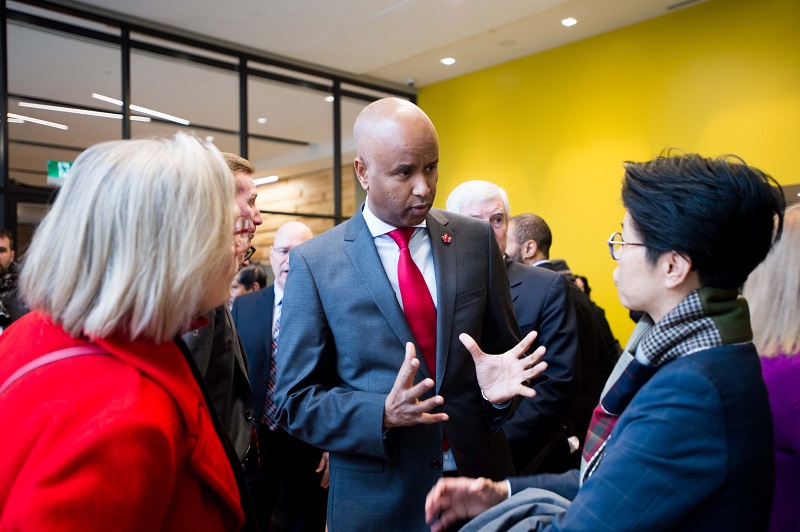
Source: Toronto Community Housing Corporation
May 7, 2021
Regent Park transformation showcased at World Urban Pavilion
Fifteen years ago, the Regent Park neighbourhood in Toronto looked quite different. Buildings needed repair and there wasn’t a bank or grocery store in site. Today, it’s a bustling community with a world-class recreation centre, aquatic centre and renewed greenspace. The story of the transformation is about to have a home too, in the heart of the community.
The Regent Park World Urban Pavilion is a collaboration between The Urban Economy Forum Association (UEFA), UN-Habitat and CMHC. The Pavilion will serve as a knowledge exchange hub.
The Pavilion will welcome cities and countries from around the world to learn about the Regent Park transformation and from each other. It will comprise a virtual platform and a physical presence on the 2nd floor office space of the DuEast Condominium in Regent Park. It will be a meeting place to discuss global urbanization and building stronger, more inclusive cities.

Minister Hussen at Canada Housing Benefit announcement December 19, 2019.
Canada’s first social housing development
Someone who knows first-hand how far Regent Park has come, is the Honourable Ahmed Hussen. As a university student in his 20s, Minister Hussen lived on the 10th floor of an old building in Regent Park, Canada’s first social housing development.
Now the Minister of Families, Children and Social Development for the Government of Canada and a Member of Parliament since 2015, Minister Hussen recalls both the opportunities and challenges his apartment on Belshaw Place provided.
The feel of the neighbourhood was tough.
“There were structural issues, a leaking roof, a non-operational elevator, but it was a roof over my head, and it benefited me,” says Minister Hussen.
“It was subsidized so it helped me pay for school. I was working a minimum wage job. Without that apartment, I wouldn’t have been able to finish school.”
At the time, the neighbourhood of about 10,000 people needed significant upgrades to buildings and infrastructure. There were also major issues with unemployment and safety.
“The feel of the neighbourhood was tough,” says Minister Hussen.

Source: Toronto Community Housing Corporation
Residents work to improve their neighbourhood
He wanted to create change. Together with Regent Park residents Debra Dineen and Diane MacLean, Minister Hussen founded the Regent Park Community Council. As president, he worked with city partners to protect the interest of residents, while helping to secure the Regent Park revitalization, a multi-year, multi-billion-dollar community redevelopment project.
Still ongoing, the first three phases of the revitalization by Toronto Community Housing Corporation (TCHC) and The Daniels Corporation have transformed Regent Park into a mixed-income, self-sufficient community.
The neighbourhood now has essential services which had been absent from the community for decades. These include a grocery store and a bank.
“It’s amazing what they have done with the place,” says Minister Hussen, citing the new aquatic centre, recreation facilities and renewed greenspace as examples.
The World Urban Pavilion will help us to rethink the importance of urbanization and will be a place to dream and to act.
Former TCHC president and CEO Kevin Marshman notes Minister Hussen’s contribution to Regent Park’s remarkable transformation.
“When he lived in the community, he played an important role in securing the revitalization and in advocating for the interests of Regent Park residents,” says Marshman. “And Minister Hussen continues to be a strong supporter of the community today.”

L to R: TCHC chief development officer Vincent Tong with Minister Hussen at Canada-Ontario Housing Benefit announcement, December 19, 2019.
The World Urban Pavilion: A place for learning and collaboration
The Pavilion partners are excited about the synergies and learning opportunities it will provide.
“The World Urban Pavilion will help us to rethink the importance of urbanization and will be a place to dream and to act,” says Eduardo Lopez Moreno, the Director of Research and Capacity-Building for UN-Habitat.
“We will create contextual-based pilot projects with cities and countries around the world,” says Reza Pourvaziry, Chair of the Urban Economy Forum. “This will bridge the gap between theory and implementation and to share knowledge and innovation to realize urban sustainability.”

L to R: Minister of Crown-Indigenous Relations, the Honourable Carolyn Bennett, Member of Parliament, Toronto-St. Paul’s, Minister Hussen and Kristyn Wong-Tam, Councillor, City of Toronto at Canada Housing Benefit announcement December 19, 2019.
The World Urban Pavilion is also an additional opportunity for Minister Hussen to continue relations with UN-Habitat. In 2017, Min. Hussen visited Nairobi, Kenya, as a guest of UN-Habitat to learn more about United Nations Human Settlements Programme work in informal settlements.
According to Minister Hussen, Regent Park is an example of residents taking matters into their own hands and creating, “local solutions to local problems”.
Local voices have been at the heart of the revitalization from the very beginning.
“It’s what happens when local players work together and drive things – make sure things are done by them rather than to them,” says Minister Hussen.

L to R: Minister Hussen with CHRA executive director Jeff Morrison (centre) and former TCHC president and CEO Kevin Marshman at Canada's Housing Benefit announcement, December 19, 2019.
At a glance
- Regent Park is the first in a series of success stories to be featured at the World Urban Pavilion.
- The Pavilion is showcased in partnership with the National Housing Strategy’s Demonstrations Initiative, which highlights innovative solutions to affordable housing challenges.
- The Government of Canada, through Canada Mortgage and Housing Corporation, will contribute CAD$1 million for the construction of the Regent Park World Urban Pavilion by UN-Habitat and CAD$1.25 million for five years of programming (CAD$250K per year) through the National Housing Strategy

